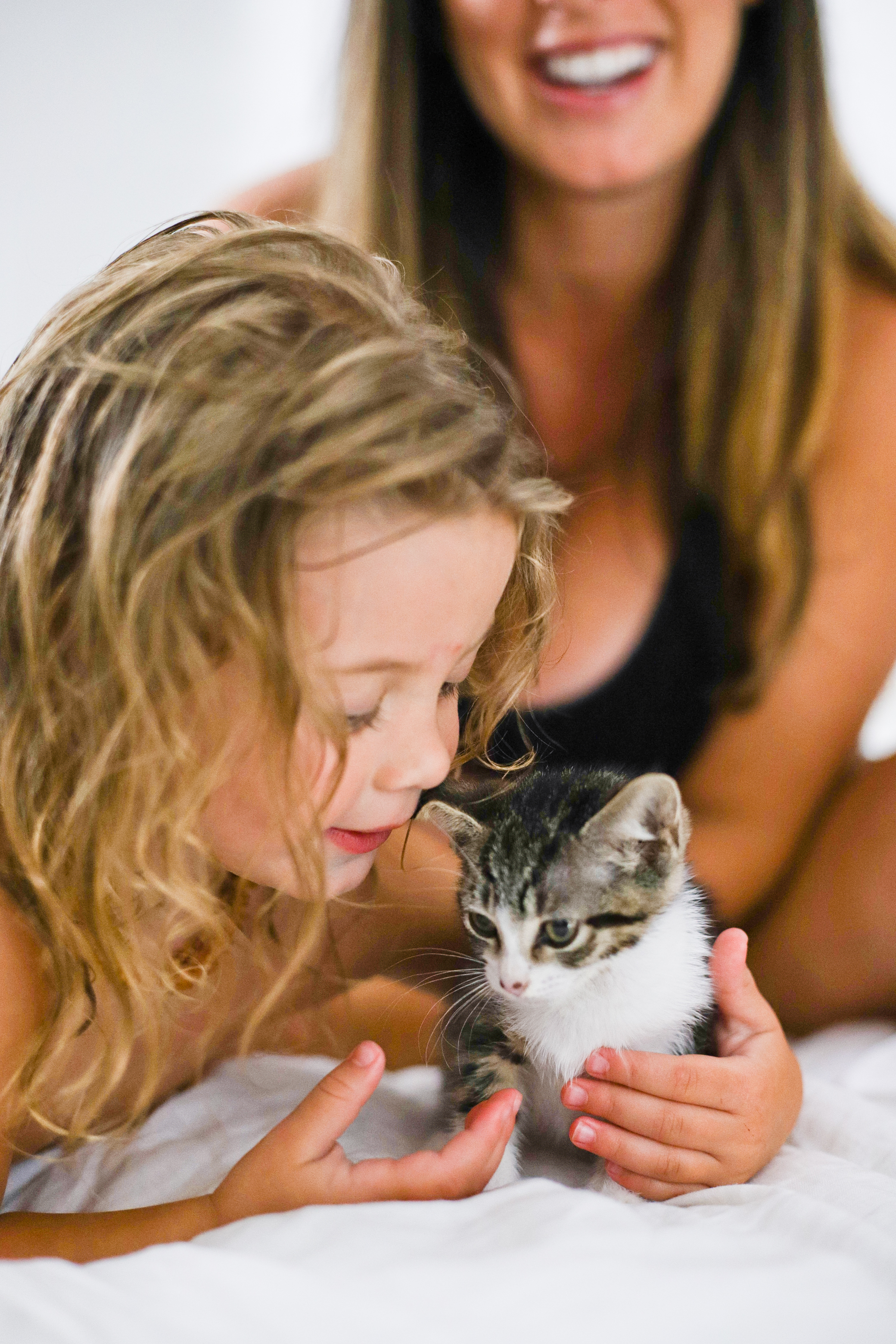Do you have a new kitten or an older cat, that is having trouble using the litter box? Often, this frustrating issue can be solved with simple changes to your litter box setup and making sure that your cat is physically healthy and happy. Read more for 8 easy steps on how to train your cat to use the litter box.



We’ve had our share of cats in the home and many that we’ve had to train, and even re-train to use the litter box after a big life event – like a move or introducing a baby. Some tips are from research, some are tips from our vet and most we’ve used successfully to keep our home clean and kitties using the box!
How to Train Your Cat to Use the Litter Box
Table of Contents
1. Choosing the Best Litter Box
If you have a new kitten then you will need a litter box with sides that are low enough to allow them to enter and exit easily. But if you are wondering how to train your cat to use the litter box and he is a little older, control his bad aim with higher sides that will keep the waste from falling on the floor.
You will want to find a litter box made from heavy, durable plastic so it is easy to clean and holds up well over time. You will also want to make sure your litter box is big enough for your furry friend to turn around and kick the litter. This is normal behavior for him to do so accommodate it.
After they’ve grown accustomed to a litter box, and are large enough to climb into one, you can use an automatic cleaning litter box. We have the Litter-Robot and it’s cut back on the cleaning time tremendously!!!


2. Consider the Litter Box Setup
There is an equation to find out the number of litter boxes for your household. They should equal the number of cats you have, plus one. It is common for multi-cat homes to be short on the needed number of litter boxes.
Place your cat’s box in an area of the house that is quiet and easily accessible. If you’re having trouble with a cat that used to be an outdoor cat—or is an indoor/outdoor cat—it may be best to place a litter box near the door. You can also try placing the litter box wherever your cat feels comfortable and then gradually move it to your desired location.
3. Introducing Your Cat to The Litter Box
An important step in how to train your cat to use the litter box is encouraging litter box use. Place your fur friend in the litter box after meals, playtime, naps, and whenever you think he may need to “go.” Keep this up during the first few days with your new pet, and you should achieve litter box success in no time.

4. How to Train Your Cat to Use the Litter Box Using Cat Attract and Feliway
There are a couple of products you can try if you need a little extra help with the litter box training.
Cat Attract is the first cat litter that is blended with a natural herb attractant to help problem pets. It features superior odor control, hard clumping, and is 99% dust-free. You can use it for multi-cat households and kittens.
Another awesome feature is that it can be used in sifting/mechanical litter boxes, like the one we have. Many cat experts swear by it, and a fairly reasonable price it is definitely worth a try.
A Feliway diffuser mimics your cat’s natural facial pheromones and the scent will comfort and reassure him. This is helpful for skittish cats, or under stress caused by a variety of reasons including a new home or new pet. Many trainers encourage the use of this product, but it is not likely a quick fix—but hey, it can’t hurt.
5. Clean the Affected Space
In combination with any of the remedies on this list, you will want to be certain to thoroughly clean EVERY old accident spot with an enzyme cleaner. You may have used bleach and have a false sense of security, but this doesn’t eliminate the scent to your animal. Use a product such as Nature’s Miracle and a black light to give these spots a really good cleaning, so your fur friend doesn’t smell it and think he should go their again.
My pro-tip on how to train your cat to use the litter box in relation to eliminating unwanted pet stains is to reduce the available space your pet has. Temporarily, keep your pet confined to a smaller space, such as a bathroom, where it is easier to clean.
After we moved into our new home, we had a little bit of litter box regression from our cats, so our vet recommended to retrain them through space reduction. Essentially, unless we were holding or actively playing with them, they stayed in the bathroom for almost two weeks. Eventually and slowly they made their way back out to living in the full house, from full bathroom quarantine to only in there at night and finally, we didn’t need the reduced space anymore.
6. How to Stop a Cat from Pooping on the Floor With Cleanliness
If you’re wondering how to stop a cat from pooping on the floor it could be a very simple solution. Keeping the litter box clean is perhaps the most common mistake pet owners overlook. You need to scoop the feces from the litter box at least once a day and clean the box with soap and water once a week with completely fresh litter.
As you know cats can be finicky and many will not use a dirty box. Your pet doesn’t want to sit among stale poop or step on clumps of pee.
Check out my other post on kitten care for information on my favorite automatic litter box Litter-Robot, which is a great solution for busy pet owners.



7. Evaluate Your Cats Mental Health
The Merck Manual Veterinary Manual says, “Urine marking is more common in male cats, and neutering can help to reduce or eliminate spraying behaviors in approximately 90% of cats. Cats may spray as a form of marking or as a sign of anxiety.” Your cat’s mental health is an important part of how to train your cat to use the litter box.
Evaluating if your cat is stressed may be difficult, but there are many things you could try to perk home up. You could try playing music for him while you’re at work, playing with him more frequently using a wand toy, giving him treats using a puzzle toy, and most importantly spending personal time with him. Stress/affected mood is a very common reason for litter box issues, so trying all of these methods are well worth the effort.
8. Check Your Cat’s Health
Health can be a big factor in a sudden change in litter box behavior. So when you’re wondering how to train your cat to use the litter box if it is an adopted shelter animal you will want to have him evaluated by a veterinarian.
Pain can make a pet suspicious that the litter box is actually causing the discomfort vs. it coming from their body. Diabetes, GI issues, or joint soreness that makes it difficult to enter the litter box may cause this discomfort.
If the animal has a UTI the very act of urinating might be painful. So essentially no matter what you do to address the behavioral issue it could be pointless if your pet has a serious physical issue. Please look at every angle when investigating how to train your cat to use the litter box and good luck.


With our two rescue cats in our household, along with the new foster kitten we’ve been taking care of until she’s adopted, we’ve had our share of recent litter box training and would love to hear from you too!








Kathi says
Such helpful tips. No one wants to give up a kitty for misunderstood reasons. Thank you!
Cathi says
It’s a very difficult task to train a cat to use a litter box. But you can train a cat by choosing a litter box that your cat loves to sit in it, and there are many methods like that by which you can train your cat.